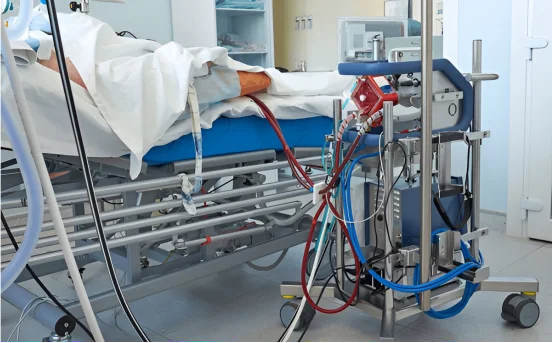Roux-en-Y Gastric Bypass Surgery stands out as one of the most commonly performed and highly effective options. This procedure has been practiced for decades and continues to be a gold standard in the treatment of morbid obesity. Its dual approach restricting food intake and reducing nutrient absorption results in significant and long-term weight loss, often accompanied by the resolution or dramatic improvement of obesity related health conditions.
Obesity is a growing health concern across the globe, leading to life-threatening conditions like type 2 diabetes, high blood pressure, heart disease, and sleep apnea. For individuals struggling to lose weight through diet and exercise alone, bariatric surgery offers a life-changing solution. One of the most commonly performed weight loss surgeries worldwide is Roux-en-Y Gastric Bypass Surgery.
What is Roux-en-Y Gastric Bypass Surgery?
Roux-en-Y Gastric Bypass (RYGB) is a type of bariatric surgery designed to help severely obese individuals lose weight. It involves both restrictive and malabsorptive components, meaning it reduces the size of the stomach and alters the digestive tract to limit calorie and nutrient absorption.
Named after the Swiss surgeon César Roux, who first described the technique in the late 19th century, the “Y” shape in its name refers to how the small intestine is reconfigured during surgery.
How Roux-en-Y Gastric Bypass Works
The procedure is typically performed laparoscopically, using small incisions and a camera to guide the surgeon. It involves two main steps :-
-
Stomach Reduction (Gastric Pouch Creation) :-
The surgeon divides the stomach into two sections. A small pouch, about the size of an egg, is created at the top and becomes the new, smaller stomach. The rest of the stomach is bypassed and no longer stores or digests food. -
Intestinal Bypass (Roux Limb Connection) :-
The small intestine is divided. One section, called the “Roux limb,” is connected to the new stomach pouch. This reroutes food to bypass a portion of the small intestine, reducing calorie and nutrient absorption.
Who is a Candidate for Roux-en-Y Gastric Bypass?
This surgery is generally recommended for individuals who :-
-
Have a Body Mass Index (BMI) of 40 or higher
-
Have a BMI of 35 or higher with obesity-related conditions such as diabetes, hypertension, or sleep apnea
-
Have not achieved long-term weight loss through diet, exercise, or medication
-
Are physically and mentally prepared for major surgery and lifelong lifestyle changes
A thorough evaluation by a bariatric surgeon and a multidisciplinary team is essential to determine if RYGB is the right choice.
Benefits of Roux-en-Y Gastric Bypass Surgery
Significant and Sustained Weight Loss
Patients typically lose 60-80% of their excess body weight within 12-18 months after surgery, leading to improved mobility and quality of life.
Improvement or Resolution of Obesity-Related Conditions
RYGB can dramatically improve or even resolve conditions such as :-
-
Type 2 diabetes
-
High blood pressure
-
High cholesterol
-
Obstructive sleep apnea
-
Gastroesophageal reflux disease (GERD)
Enhanced Longevity
Numerous studies have shown that individuals who undergo gastric bypass have a lower risk of death from cardiovascular disease, cancer, and diabetes compared to those who remain morbidly obese.
Improved Mental Health and Self-Esteem
Many patients report reduced symptoms of depression, anxiety, and enhanced self-image post-surgery.
Risks and Complications of Roux-en-Y Gastric Bypass
As with any surgical procedure, RYGB carries potential risks. While the procedure is generally safe, possible complications include :-
-
Short-term risks :-
-
Infection
-
Bleeding
-
Blood clots
-
Anesthesia-related complications
-
Leaks in the gastrointestinal connections
-
-
Long-term risks :-
-
Nutritional deficiencies (especially of iron, calcium, vitamin B12, and folate)
-
Dumping syndrome (rapid emptying of stomach contents into the small intestine)
-
Bowel obstruction
-
Gallstones
-
Marginal ulcers
-
To minimize these risks, patients must commit to regular follow-ups, nutritional monitoring, and lifestyle adjustments.
Life After Roux-en-Y Gastric Bypass Surgery
Diet and Nutrition
Following surgery, patients must adhere to a specific diet progression :-
-
Stage 1 :- Clear liquids
-
Stage 2 :- Full liquids
-
Stage 3 :- Pureed foods
-
Stage 4 :- Soft foods
-
Stage 5 :- Regular low-fat, high-protein meals
Patients are encouraged to eat small, frequent meals, chew thoroughly, and avoid sugary or high-fat foods that can trigger dumping syndrome.
Physical Activity
Gradual increase in physical activity is encouraged post-surgery. Walking is often recommended initially, followed by more structured exercise routines as recovery progresses.
Supplementation
Due to reduced nutrient absorption, lifelong supplementation is usually necessary. Common supplements include :-
-
Multivitamins
-
Calcium with vitamin D
-
Iron
-
Vitamin B12
Psychological Support
Adjusting to lifestyle changes post-surgery can be challenging. Support groups, therapy, or counseling can help patients stay motivated and emotionally healthy.
Recovery Timeline
-
Hospital Stay :- Most patients stay in the hospital for 2–3 days.
-
Initial Recovery :- Full recovery may take 3–5 weeks, depending on individual healing and any complications.
-
Return to Work :- Many return to desk jobs within 2–3 weeks; physically demanding jobs may require 4–6 weeks off.
-
Follow-up Appointments :- Regular checkups are necessary at 1 week, 1 month, 3 months, 6 months, and annually to monitor weight loss, nutrition, and overall health.
Long-Term Success Tips
-
Stick to Your Diet Plan :- Follow your dietitian’s guidance strictly.
-
Avoid Grazing :- Eat planned, portion-controlled meals.
-
Stay Active :- Incorporate at least 150 minutes of exercise weekly.
-
Keep Up with Supplements :- Take them as directed to prevent deficiencies.
-
Attend Follow-ups :- Regular visits help track progress and detect any issues early.
Alternatives to Roux-en-Y Gastric Bypass
If RYGB is not suitable, other bariatric surgery options may be considered :-
-
Sleeve Gastrectomy :- A restrictive procedure that removes a portion of the stomach.
-
Adjustable Gastric Banding :- Involves placing an inflatable band around the upper stomach.
-
Biliopancreatic Diversion with Duodenal Switch (BPD/DS) :- A more complex surgery with greater malabsorption.
Each procedure has its own benefits and risks and should be chosen based on individual health needs and goals.
Conclusion
Roux-en-Y Gastric Bypass is a powerful tool in the fight against severe obesity. It not only promotes significant and sustained weight loss but also improves or resolves many life-threatening health conditions. However, it requires a lifelong commitment to healthy living, dietary adherence, and regular medical supervision.























